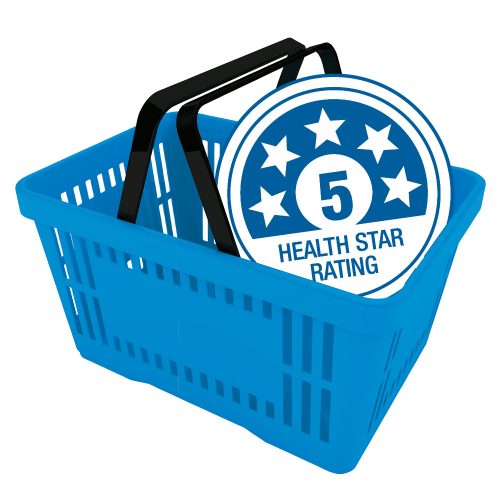
You’ve probably seen the new Health Star Rating symbol that’s now appearing on some packaged foods. HFG senior nutritionist Rose Carr takes a closer look at it.
We all know it can be difficult to decipher the nutrition information on packaged foods. We’re advised to choose more unsaturated fats over saturated fats, reduce our sodium intake from salt and choose foods with little or no added sugar. And that’s just for starters.
But when we’re confronted with trying to choose between different packaged foods, where one can have less sodium but more saturated fat, or one is higher in fibre but also higher in sugar, it’s often not that simple.
Developed in collaboration with the government, the food industry and public health and consumer groups, the Health Star Rating is designed to help us.
What does it look like?

How are the stars calculated?
The Health Star Rating is based on a mathematical calculation that takes into account the nutrition profile of the product, weights the importance of the different components then produces an overall score, which is translated into the number of stars the product gets.
Energy, saturated fat, sodium, sugar, fibre and protein are all included in the calculation. It also takes into account the amount of fruit, vegetables, nuts and legumes in the food.
Compare products within categories
The star rating can be from half a star to five stars: the more stars it gets, the healthier it is. There’s one really important thing to remember though: we can only compare products within a category. Within the system there are categories and the calculations for the stars take into account the different nutrition profiles for the types of food products.
So when we are looking at breakfast cereals, for example, we can compare the Health Star Ratings of different cereals to see which ones are the healthiest.
However, we can’t take a breakfast cereal with five stars and say that is healthier than a yoghurt with fewer stars. These products are nutritionally very different, so the rating on the yoghurt is only useful as a comparison with other yoghurts.
What products will it be on?
The Health Star Rating system has been designed to be used on packaged foods, so you won’t see it on whole foods such as vegetables, fruit and meat. You also won’t see it on food from takeaways or restaurants.
Using the Health Star Rating is voluntary, so even if it can be used on a product, the manufacturer may decide not to use it. Keep in mind too that it may take some time for manufacturers to update their packaging. If you want to know about a specific product that doesn’t feature a Health Star Rating, you could contact the manufacturer to ask them when you can expect to see it.
Is it different from the Heart Foundation Tick?
The Heart Foundation tick is also designed to help us choose healthier products within a category. The focus of the tick is on specific nutrient criteria, such as an upper limit for sodium and/or saturated fat, for products within more tightly defined categories.
Both symbols are voluntary however, the star rating symbol is free to use whereas the Heart Foundation charges a fee to use the tick.
Why we like it
Nutrition is complex and it’s difficult to summarise simply what’s healthy and what’s not. The stars simply communicate how a product compares with other similar products. And it’s an independent rating backed by the government, so there’s no bias. This system will also encourage manufacturers to make changes to their products so they’re healthier and gain more stars.
What to watch for
One anomaly is that 100 per cent fruit juice gets 5 stars but we need to remember fruit juice is no longer counted as a fruit serve, because it’s so high in free sugars. This highlights that the star rating cannot tell us about frequency of use or sensible portion sizes. We need to think about those ourselves.
Bottom line
The Health Star Rating is a really useful tool for comparing and choosing healthier packaged foods. But remember, the health stars are not on whole foods, which are the basis of a healthy diet.
Article sources and references
- Ministry for Primary Industries. Health Star Ratings www.foodsmart.govt.nz/whats-in-our-food/food-labelling/front-pack-labelling Accessed January 2016https://www.mpi.govt.nz/food-safety/food-safety-for-consumers/understanding-food-labels/health-star-ratings/
- Ministry of Health. Making Healthier Food Choices www.health.govt.nz/your-health/healthy-living/food-and-physical-activity/healthy-eating/making-healthier-food-choices Accessed January 2016https://www.health.govt.nz/your-health/healthy-living/food-activity-and-sleep/healthy-eating/making-healthier-food-choices
- Heart Foundation. 2015. Tick and Health Stars working together www.heartfoundation.org.nz/news-blogs-stories/blogs/tick-and-health-stars-working-together Accessed January 2016https://www.heartfoundation.org.nz/about-us/news/blogs/tick-and-health-stars-working-together
www.healthyfood.com










